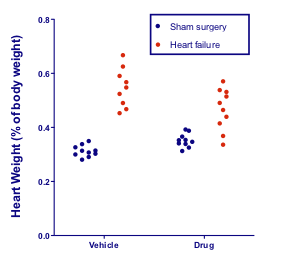Case Study: Does a drug prevent cardiomegaly in heart failure?
Case-study problem
One consequence of heart failure is that the heart gets larger (cardiomegaly). This is a physiological adaptation to allow the heart to pump enough blood to perfuse the organs. Eventually the heart grows so large it is not able to pump blood efficiently. Therefore it makes sense to seek a drug that would reduce cardiomegaly in heart failure.
This study tested such a drug in an animal model of heart failure. Half the rats were given the surgery to create heart failure, and half were given sham surgery. In each of those groups, half of the rats were injected with an experimental drug and half were injected with vehicle as a control. (The data are real, but the investigators prefer to remain anonymous).

|
|
Sham surgery |
CHF |
||||
|
|
Mean |
SD |
n |
Mean |
SD |
n |
|
Vehicle |
0.3124 |
0.0211 |
10 |
0.5481 |
0.0723 |
9 |
|
Drug |
0.3518 |
0.0251 |
10 |
0.4669 |
0.0768 |
10 |
Is the drug effective in blunting the increase in heart weight?
Think about how you would analyze the data before reading the case-study. Better, download the raw data and do your own analyses.
Discussion of this case study
When you have thought about how you would analyze the data, read this 15 page case-study.
Here is the corresponding Prism file.
Write me
This is the first in a series of case studies we're creating to help scientists learn the fine points of data analysis.
Please contact us at help.graphpad.com with your suggestions about this case study, or ideas for future case studies.
Emailed comments (updated Jan 29, 2010)
- "It is quite common for medications to disturb eating or other physiological parameters. The assumption that growth in body weight with age is unchanged by the experimental drug would need to be proven. Is the heart really changing, or is the ratio of heart to body weight changing because the treated animals are eating less? I would also want to look at other markers of heart failure beyond heart weight."
- "The case study missed an opportunity to emphasize that it's important to have interaction between the person who designed/conducted the experiment and the data analyst. If the investigators had come to me for help with the analysis, I would have started by asking what question(s) they wanted to answer, why they included a vehicle group and why they included sham operated animals. I know that this might seem self-evident, but I've often been surprised by what questions the people who designed/conducted the experiment actually wanted to answer" (Jerry Gardner, M.D., President, Science for Organizations).















